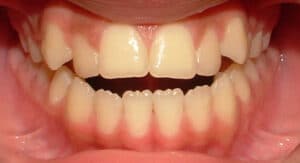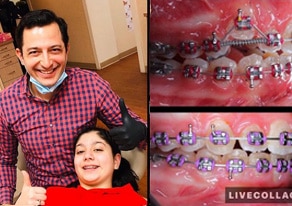Finishing Invisalign treatment is a big step. For most patients, it means straighter teeth and improved confidence. But in some cases, new concerns can appear after the aligners are done. One of the most common is bite issues after Invisalign Treatment.
If your bite feels off after completing your trays, you’re not alone. Some patients experience discomfort or notice their teeth don’t come together the way they should. These issues can affect your jaw, chewing, or overall comfort. The good news is that bite alignment problems can often be corrected with the right follow-up care.
Take a closer look at why these issues happen and what you can do about them.
Why Bite Issues After Invisalign Can Occur

Even with a precise treatment plan, some patients may notice changes in their bite once Invisalign ends. These shifts can be subtle or more noticeable, depending on the cause.
Here are some common reasons this can happen:
Incomplete Movement or Early Tray Removal
If aligners aren’t worn for the full recommended time each day, certain teeth may not fully shift into place. Even small delays in movement can throw off how your bite comes together.
Teeth Shifting After Treatment
Once the trays come off, teeth may try to move back to their original positions. Without proper retainer use, this relapse can lead to bite problems.
Issues With Scans or Impressions
Invisalign relies on detailed digital scans to create a treatment plan. If those scans are slightly off, the outcome may not match the intended bite alignment.
Missed Jaw Alignment Concerns
While Invisalign focuses on teeth alignment, it may not fully correct complex jaw-related bite problems. These sometimes need additional treatments that weren’t part of the original plan.
Improper Retainer Use
Retainers are essential to keeping your new smile in place. Skipping wear or improper fit can allow unwanted changes in your bite over time.
Signs and Symptoms of Bite Discomfort After Invisalign
It’s not always obvious that something is wrong with your bite. Some symptoms can be mild at first, but they may become more noticeable as time goes on. Recognizing early signs of bite discomfort after Invisalign can help you act before the problem gets worse.
Here are some things to look out for:
-
Jaw tension or soreness – A common sign that your bite isn’t aligned correctly.
-
Clicking or popping when chewing – This could mean your jaw joint is under stress.
-
Teeth that don’t meet evenly – If your top and bottom teeth no longer fit together as they used to.
-
Tooth sensitivity – Especially when biting or chewing in one specific area.
-
Headaches or facial pain – A result of muscle strain from an uneven bite.
-
Chewing discomfort or difficulty – If eating feels awkward or uncomfortable.
If you’ve just completed treatment and notice one or more of these signs, it’s important to let your orthodontist know. These symptoms are often linked to Invisalign treatment bite issues and may require adjustments to prevent them from becoming long-term problems.
Even small bite shifts can affect your quality of life, so early attention makes a big difference.
How to Fix Bite Issues After Invisalign
If your bite feels off after completing Invisalign, you’re not stuck with it. There are several ways orthodontists can correct post-treatment bite problems. The right solution depends on the severity and cause of the issue.
Here are some of the most common methods used to fix bite issues after Invisalign:
1. Refinement Aligners
Your orthodontist may recommend an additional set of clear aligners. These refinement trays are designed to make small adjustments and bring your bite into better alignment.
2. Retainer Adjustments or Replacements
In some cases, the retainer you’re using may be causing or worsening bite problems. A custom adjustment or switching to a different style of retainer can help maintain the correct bite.
3. Bite Adjustment (Occlusal Equilibration)
This is a minor reshaping of specific tooth surfaces. It’s used to balance your bite so that all teeth meet evenly when you close your mouth.
4. Interproximal Reduction (IPR)
If some teeth are too tightly spaced, gentle polishing between them can improve how they fit together. This can help fine-tune the bite without removing any teeth.
5. Nightguards for Clenching or Grinding
If you grind your teeth at night, a custom nightguard can prevent additional stress on your bite. This is especially helpful for patients who develop new bite discomfort after Invisalign due to jaw tension.
6. Specialist Referral
In rare cases, bite issues may be due to underlying jaw alignment that Invisalign couldn’t fully correct. If this happens, your orthodontist might refer you to a specialist for additional treatment.
Correcting your bite after Invisalign doesn’t mean your treatment failed. In fact, refinement is a normal part of many treatment plans. What’s important is getting it checked early so adjustments can be made before problems worsen.
The Role of Follow-Up Visits in Preventing Invisalign Treatment Bite Issues

Regular follow-up appointments are one of the most important parts of successful Invisalign care. These visits allow your orthodontist to monitor your progress and make small adjustments that help avoid long-term problems—including Invisalign treatment bite issues.
Even after your last set of trays, your orthodontist still needs to check how your teeth settle into place. Sometimes, the bite continues to shift slightly in the weeks or months after treatment. Without a follow-up, those changes might go unnoticed until they cause discomfort.
Here’s what typically happens during these check-ins:
-
A full bite evaluation – Your orthodontist checks how your upper and lower teeth come together.
-
Retainer fit check – Making sure the retainer holds your bite properly and isn’t causing pressure on certain teeth.
-
Monitoring for relapse – Ensuring your teeth don’t begin to move back toward their original positions.
-
Discussion of any symptoms – You’ll be asked if you’ve noticed clicking, pain, or changes in your bite.
These visits aren’t just routine—they’re key to making sure you don’t develop Invisalign treatment bite issues after the trays are done. If caught early, most problems can be fixed with minimal effort. Skipping follow-ups can delay the diagnosis of post-treatment concerns and lead to more involved corrections later on.
When Bite Correction After Invisalign is Necessary
Not all bite shifts after Invisalign require intervention, but some do. If the issue is affecting your comfort, function, or long-term dental health, your orthodontist may recommend additional steps. Bite correction after Invisalign is a common and practical part of many treatment journeys.
Here are signs that further correction may be needed:
-
Ongoing discomfort or pressure in your jaw
-
Your bite feels uneven or misaligned when chewing
-
Visible gaps or tooth movement after finishing treatment
-
You notice new speech issues or changes in how your teeth meet
-
Your retainer no longer fits the way it did originally
In some cases, refinement aligners may be all that’s needed. Other times, adjustments to your retainer or bite surface may be more effective. If your orthodontist determines that your bite issues are related to jaw structure or muscle tension, additional therapies may be recommended.
Bite correction after Invisalign doesn’t always mean starting from scratch. Small, precise steps often bring your bite back into alignment and protect the results you worked hard to achieve.
How to Advocate for Your Post-Invisalign Care
If something feels off after treatment, speaking up is important. Many patients assume mild bite changes or discomfort will go away on their own, but that’s not always the case. Being proactive can help prevent small issues from turning into long-term problems.
Here are a few ways to take charge of your post-Invisalign experience:
-
Pay close attention to changes
Keep track of how your bite feels from week to week. If chewing feels different or certain teeth don’t meet like they used to, make a note of it.
-
Report symptoms early
Don’t wait for your next scheduled visit if something feels wrong. Bite discomfort after Invisalign is easier to manage when addressed early.
-
Ask for a bite evaluation
A detailed bite check can reveal subtle alignment issues you may not notice yourself.
-
Keep wearing your retainer
Even if things feel slightly off, don’t stop wearing your retainer unless your orthodontist tells you to. Removing it without guidance can make the issue worse.
-
Be open to adjustments
Needing refinement or bite correction after Invisalign doesn’t mean your treatment failed. It’s often a normal step toward getting the best result possible.
Your orthodontist wants your bite to feel just as good as it looks. Staying involved in your care and voicing concerns helps ensure you get the support you need after Invisalign.
Conclusion
Bite issues after Invisalign can be frustrating, but they’re not unusual—and they can be corrected. Many of these problems are minor and fixable with follow-up aligners, retainer adjustments, or a simple bite evaluation. The key is to act early and stay involved in your care.
If your bite doesn’t feel quite right, trust your instincts and talk to your orthodontist. Addressing small changes now can protect your results and prevent more complex treatment later.
Your Invisalign journey doesn’t end with the last tray. With the right support, you can make sure your bite feels as good as your smile looks.
Take Control of Post-Invisalign Bite Issues Today
If your bite feels off after finishing Invisalign, don’t wait it out. At Halabi Orthodontics, we understand how crucial bite alignment is to your overall comfort and long-term results. Our team uses advanced diagnostic tools and years of expertise to pinpoint the issue and provide a personalized fix—so your bite feels just as good as your smile looks.
Schedule your consultation with Halabi Orthodontics today and let us help you protect your Invisalign results with confidence.

 CURRENT PATIENT NUMBER
CURRENT PATIENT NUMBER



 What patients are saying
What patients are saying Your smile our passion
Your smile our passion News and Events
News and Events